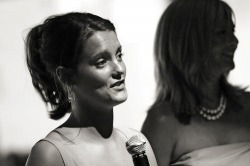Toasts

This is chance to hear very lovely (and possibly embarrassing) things in the words of people who are very close to you. Toasts may include, at one end of the spectrum, only the best man or maid of honor having everyone raise their glass to the new couple and quickly moving on; or, at the the other end, providing an open microphone to all guests and family members who would like to say a few words. If the father of the bride is giving a speech, according to tradition, he will start things off. If not, usually the best man will go first followed by the maid or matron of honor. It's very important at this time for your disc jockey to know if you were planning to allow other guests to give speeches. If there are specific people you would like to speak, the DJ should have their names and the order so he can introduce them and avoid wasted time figuring out what's coming next. This way there can be a definitive close to the toasts and the wedding DJ will immediately announce the next event without hesitation. If you would like to have an open microphone, it makes the transition a little less solid but if it's the right thing for your group of friends and family, then you shouldn't let that stop you from opening the floor to anyone who wants to speak. Occasionally the bride and/or groom will give a final speech to round out the wedding toasts.
...Microphone Tips
It's best for the people speaking to know a little bit about microphone technique. One should hold the microphone about for or five inches away from the mouth, slightly below and in front keeping it at all times pointed toward the lips. This keeps the line of sight open so people can see one's mouth as words are formed, greatly increasing the speaker's intelligibility. We understand a lot more of what people are saying if we can see their lips move. To remember to aim the microphone correctly, I like to tell people to think of it as a flashlight with which you want to light up your mouth as you talk. A flashlight is directional in much the same way as a microphone, so the image works well. Use the other hand to gesture or to point out important people. Occasionally you'll see a speaker who uses the microphone as a pointer when acknowledging people, which leaves large gaps when we can't hear anything as we wait for the mic to return to position.
